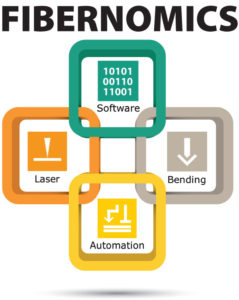Fibernomics is an all-encompassing economic principle and the key to a competitive advantage in today’s sheet metal fabricating environment. As with most economic principles, there is a basic premise, or formula, that defines the principle:
Lower Operating Costs + Faster Processing = Greater Profit & Earnings Potential
Fibernomics begins with the powerful Bystronic Fiber laser cutting machines; reducing operating costs by more than 50% and increasing processing speeds by up to 400%. Although this is the basis of the Fibernomics principle, fabricators have quickly realized the pull and push demand that the Fiber laser has also created.
Satisfying the Pull Demand:
The pull demand of Fibernomics begins at the front-end where business software systems process orders into bills of materials and job routings, as well as programming systems that provide programs for the fiber laser. All of these systems need to keep up with increased throughput and capacity created by the fiber laser.
Yet the “pull” demand on the front-end does not end with a finished cutting program. The raw material must be ready without delays in presenting it to the laser for processing. Once the laser begins processing the jobs, the consistency of the cut material unloading and raw material loading cycle times becomes critical. Completing the unload/load cycles in the time while the machine is still processing the current sheet is critical to maintaining the advantages gained from high-speed Fiber laser processing.
Satisfying the Push Demand:
The “push” demand is created by the Fiber laser as it produces up to four times more parts than a conventional CO2 laser, depending on power levels, directly impacting press brake and other downstream capacities. At this point it does not make sense to have stacks of cut parts at the press brake and not have the capacity or the throughput capabilities to take advantage of the increased productivity from the fiber laser. For this reason the “push” demand demands equal attention as does the “pull” demand. Utilizing high-speed press brakes that can produce up to 65% more bends per hour.
compared with non-high-speed brakes will certainly help keep the pace. Most of the non-productive time in bending can be found during the setup process. Eliminating non-productive time and utilizing the latest press brake technologies plays a major role in increasing productivity and creating additional capacity.
Economic Advantage:
Fibernomics isn’t just the economic advantage of owning a Fiber laser cutting machine, but the overall economic advantage that is created when all of the pull and push demands are satisfied to meet the production capabilities of the Fiber laser as well. Reducing the time from the order to the cut part, reducing material utilization costs and reducing processing times are key to the economic principle of Fibernomics. It is no longer about how a single piece of machinery will affect the fabrication process, but how all the machines and supporting software technologies work together to create a cohesive and effective fabrication business solution.
By Frank Arteaga, Head of Product Marketing, NAFTA Region
Bystronic Inc., Elgin, IL – Voice.bystronic@bystronic.com

